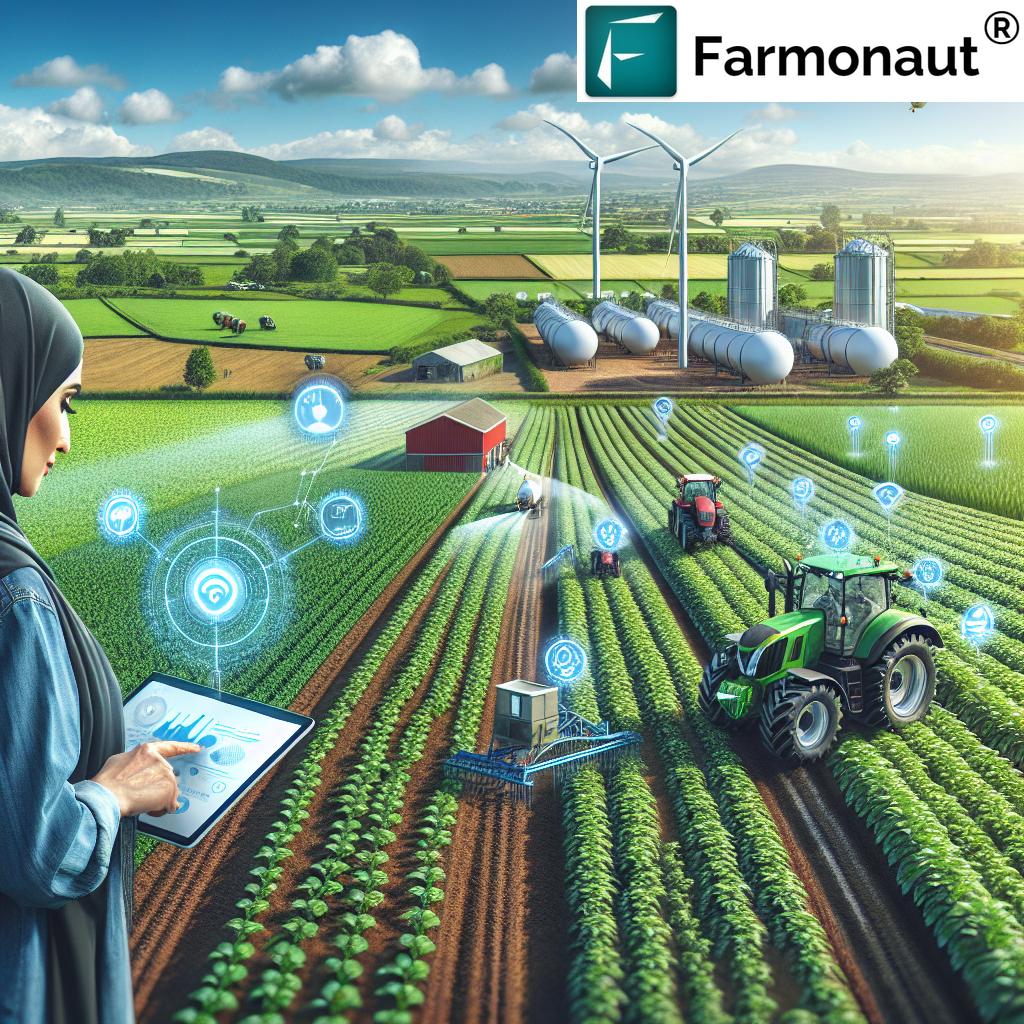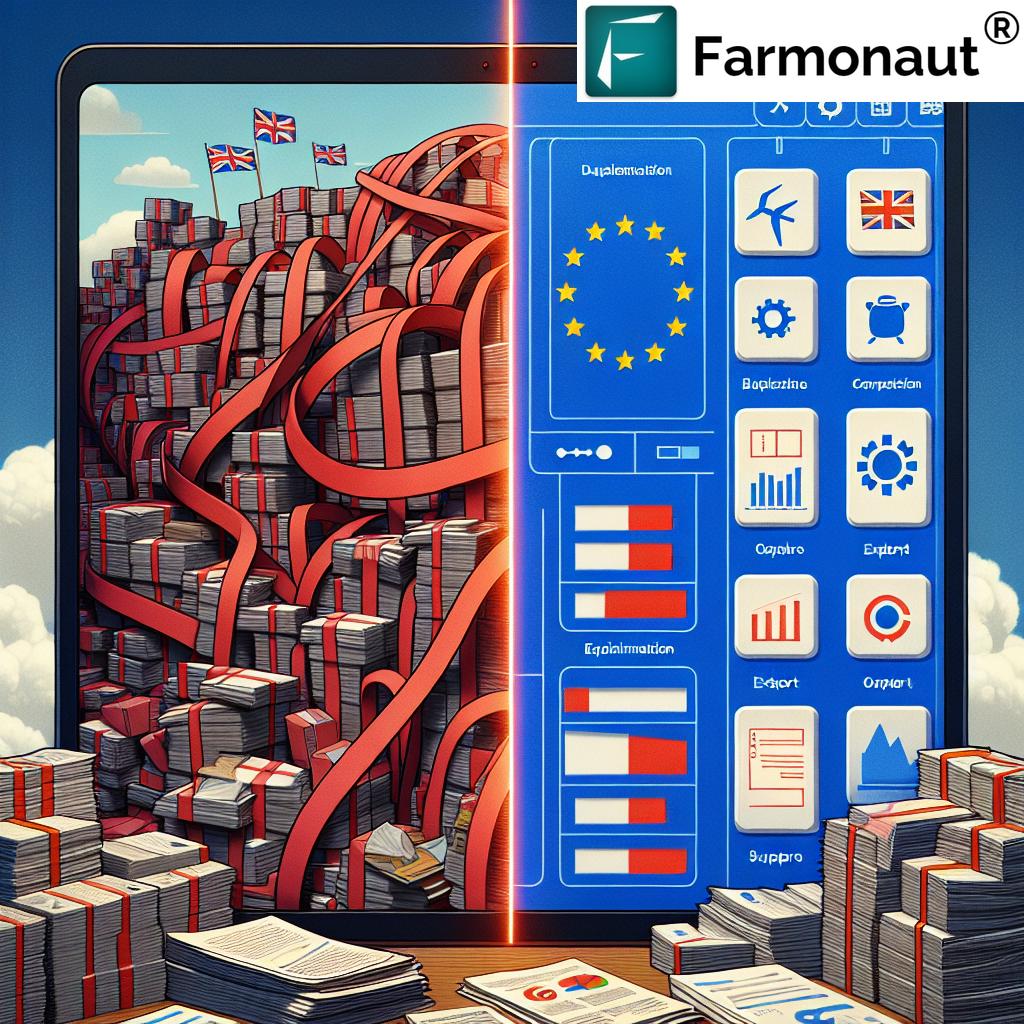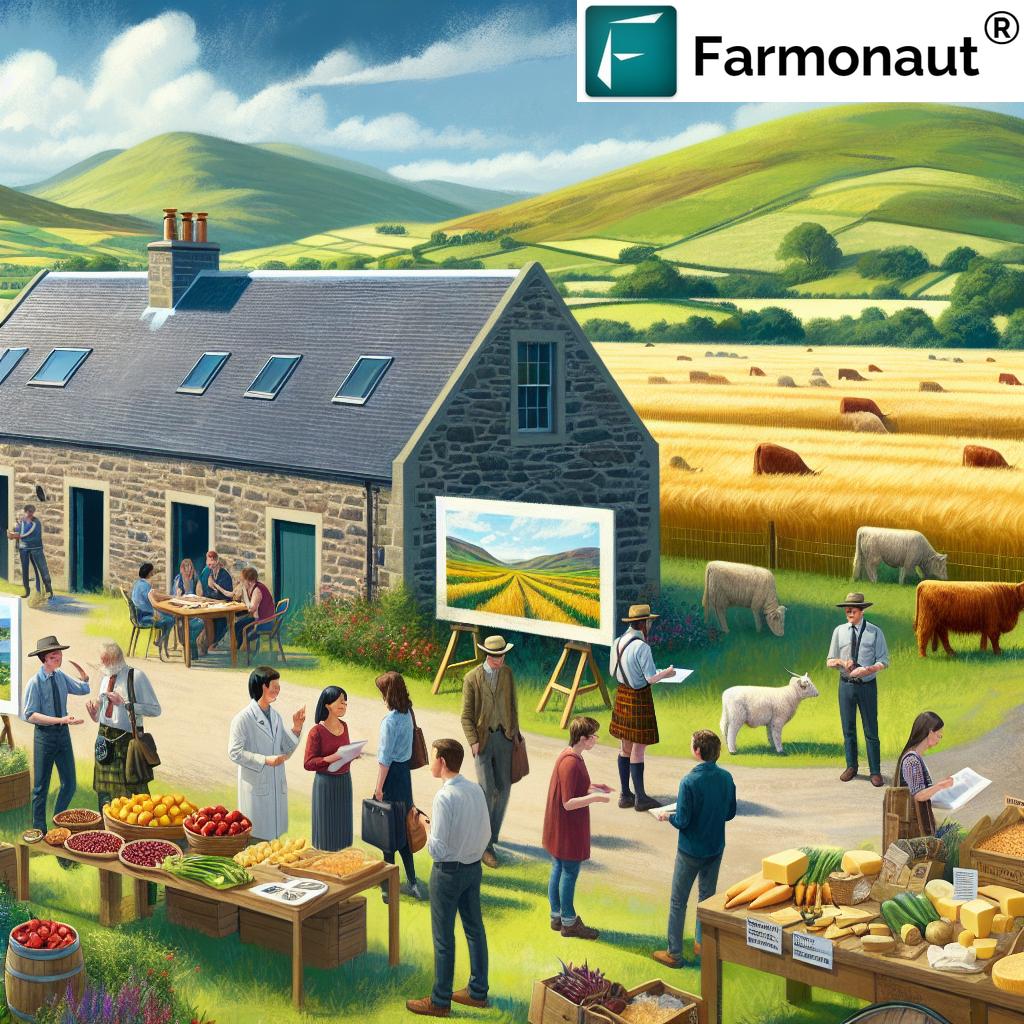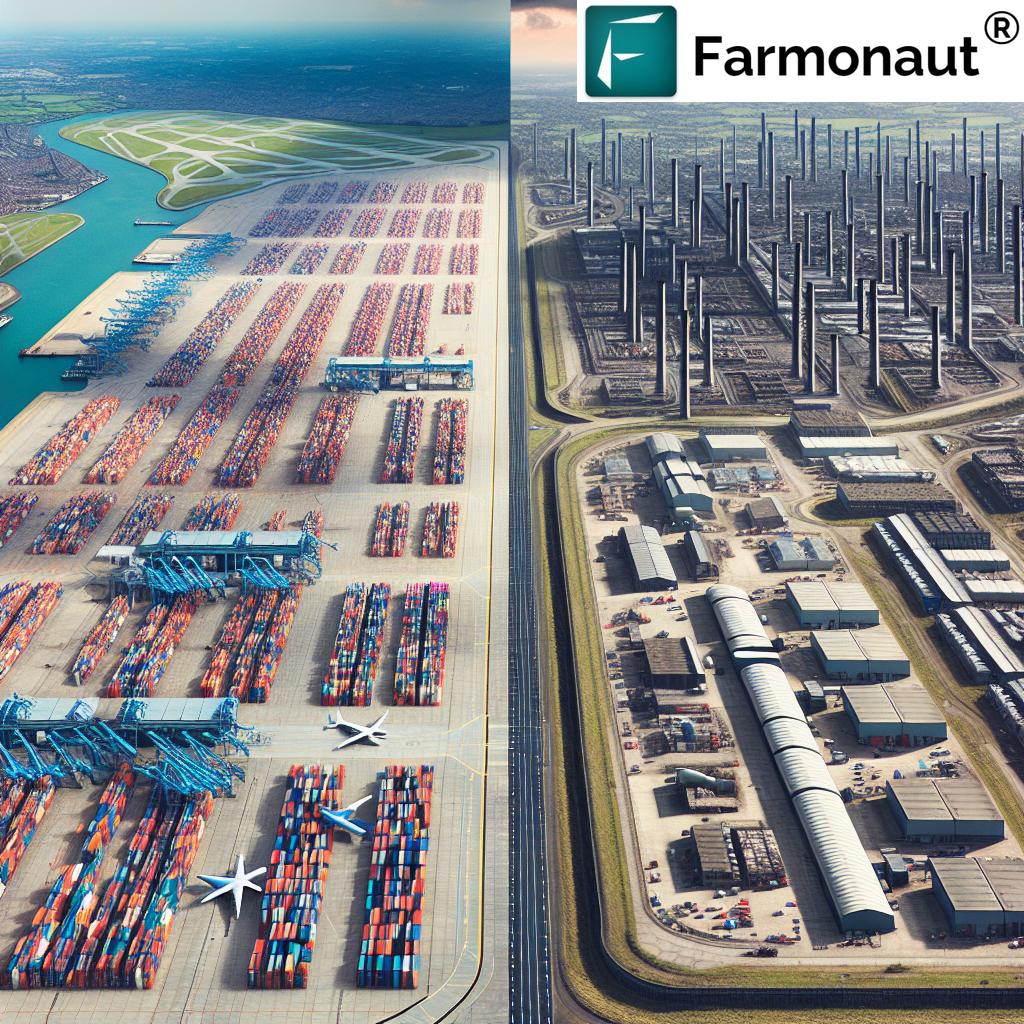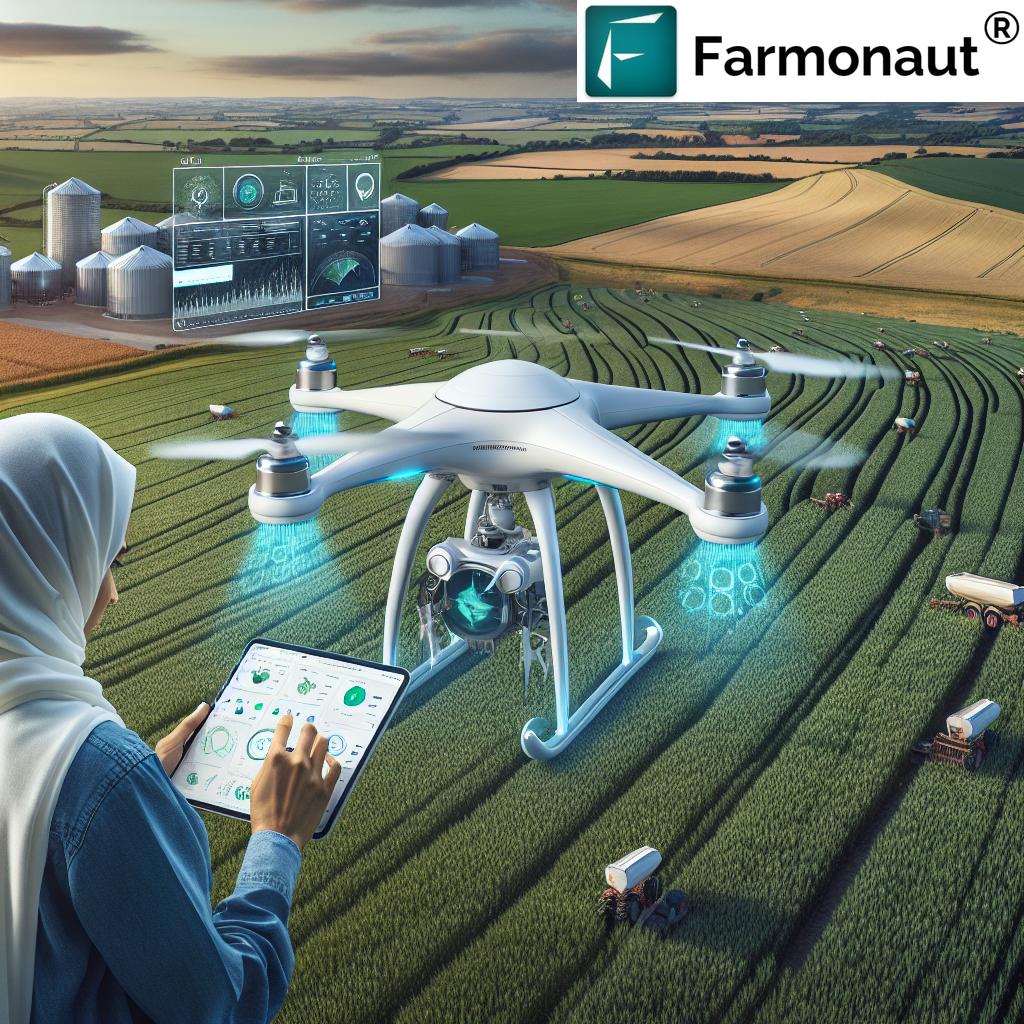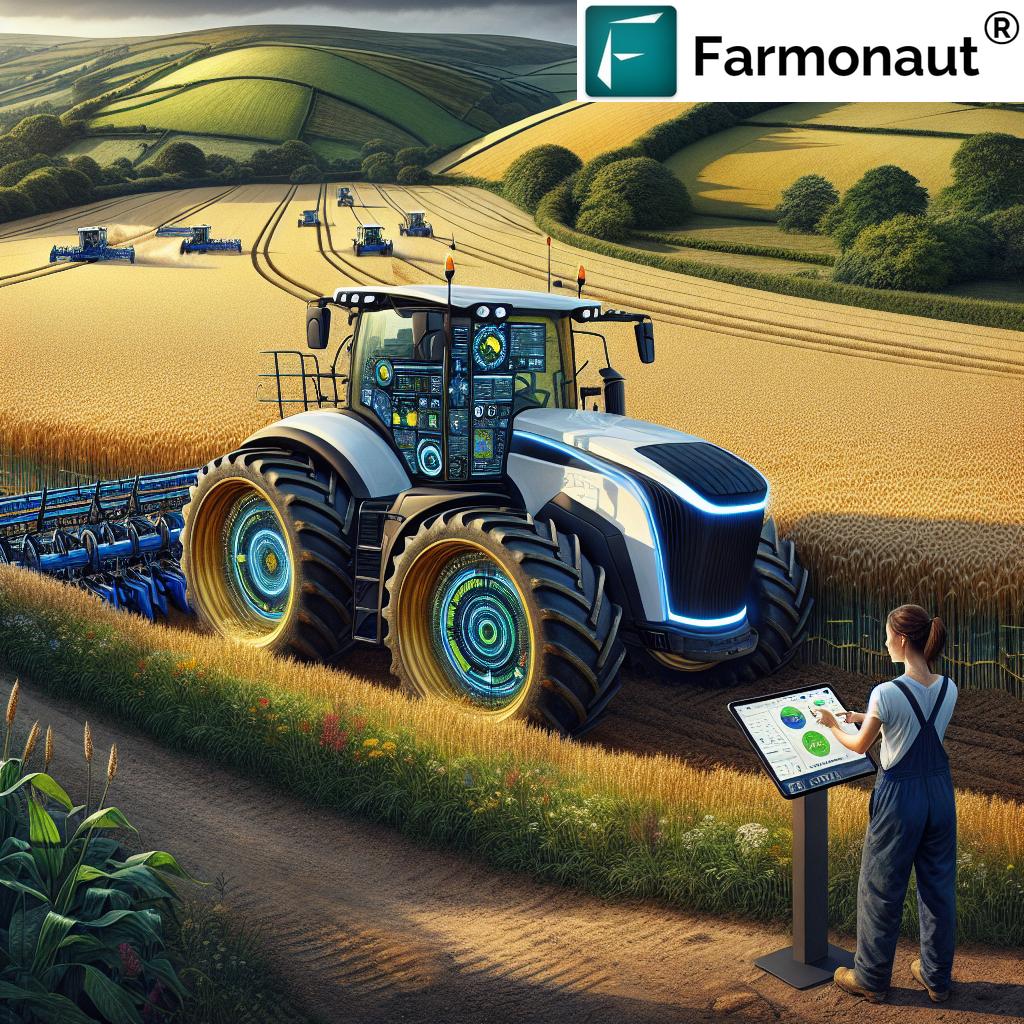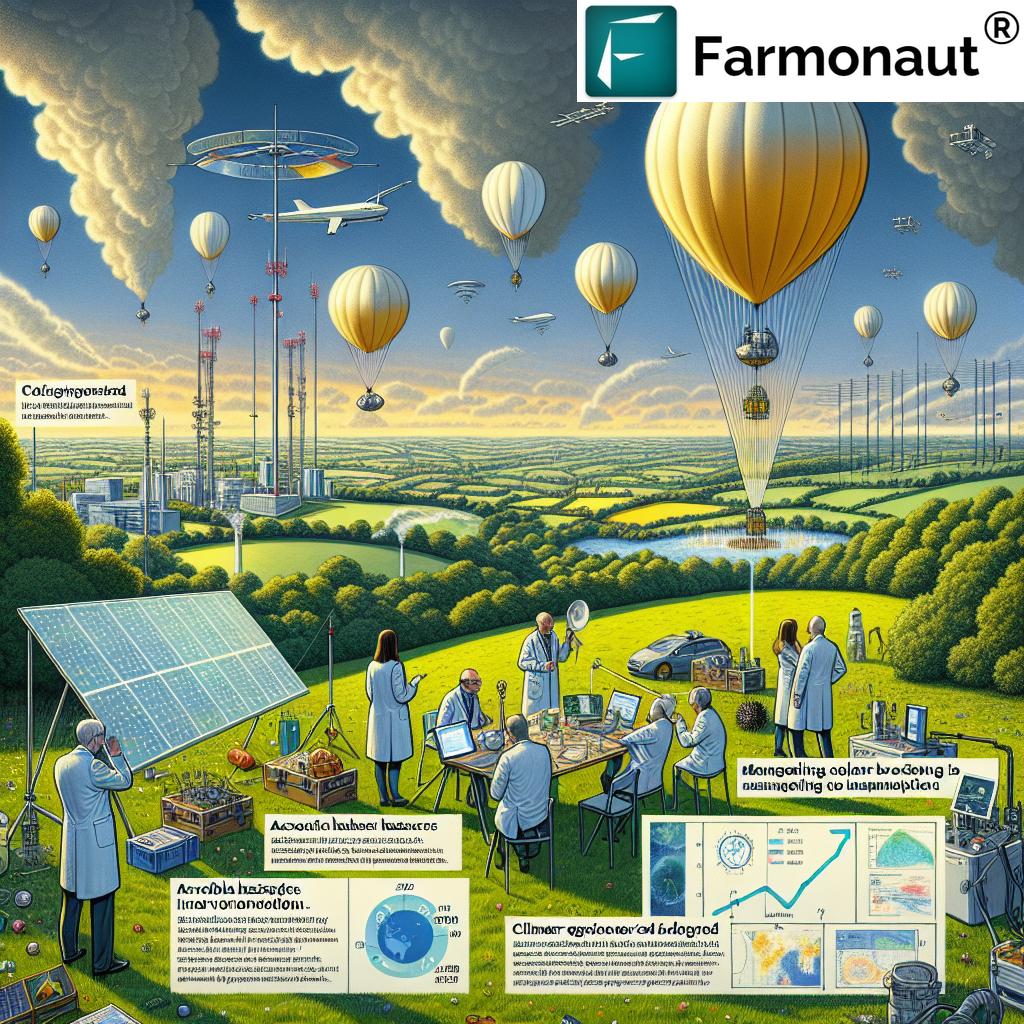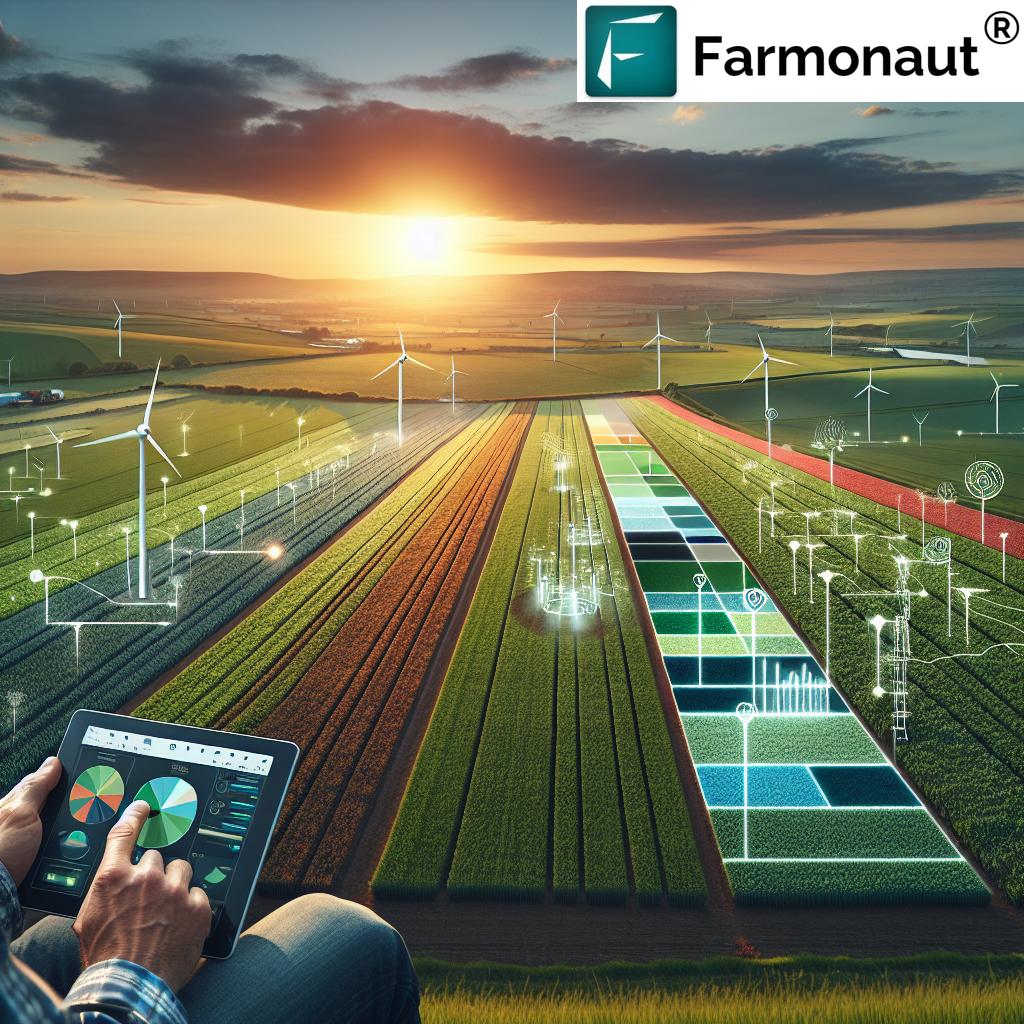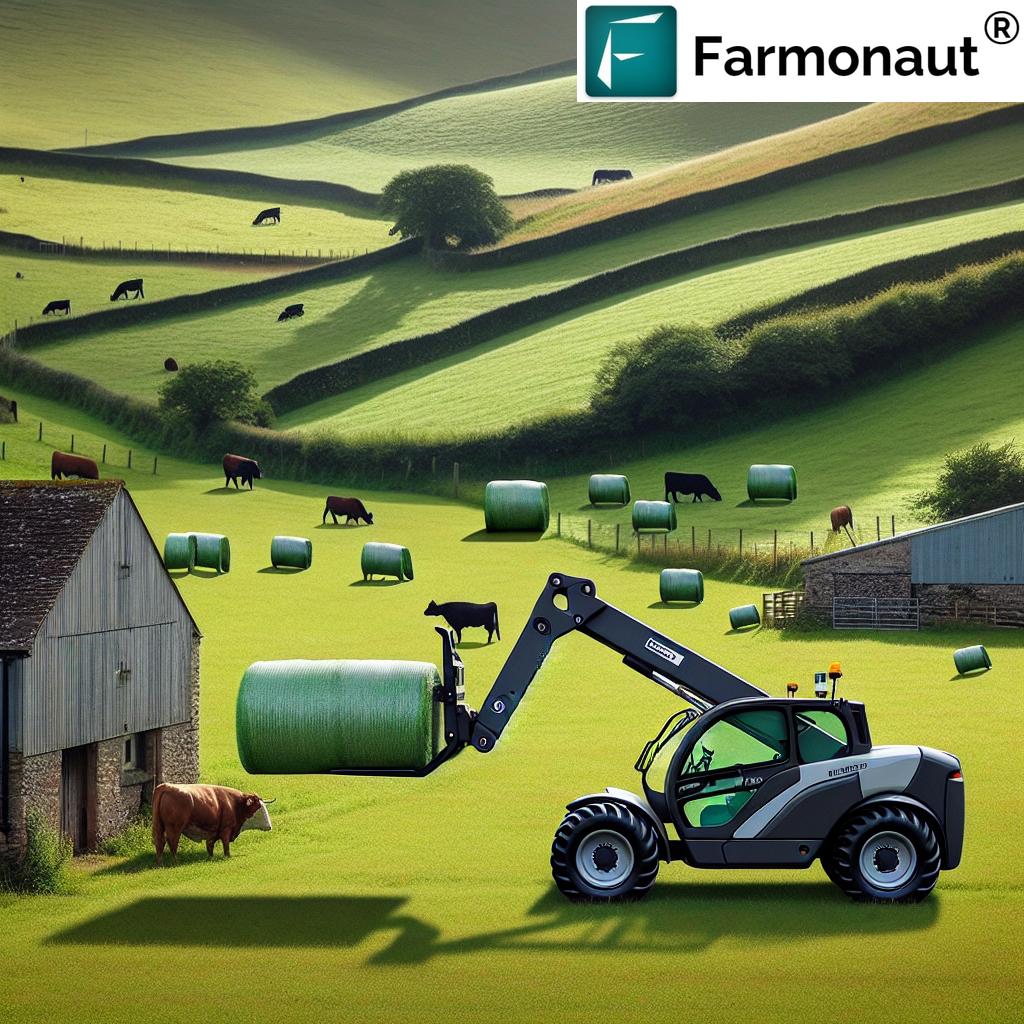Revolutionizing Scottish Farming: How GIS and Remote Sensing Boost Sustainable Agriculture in Castleton
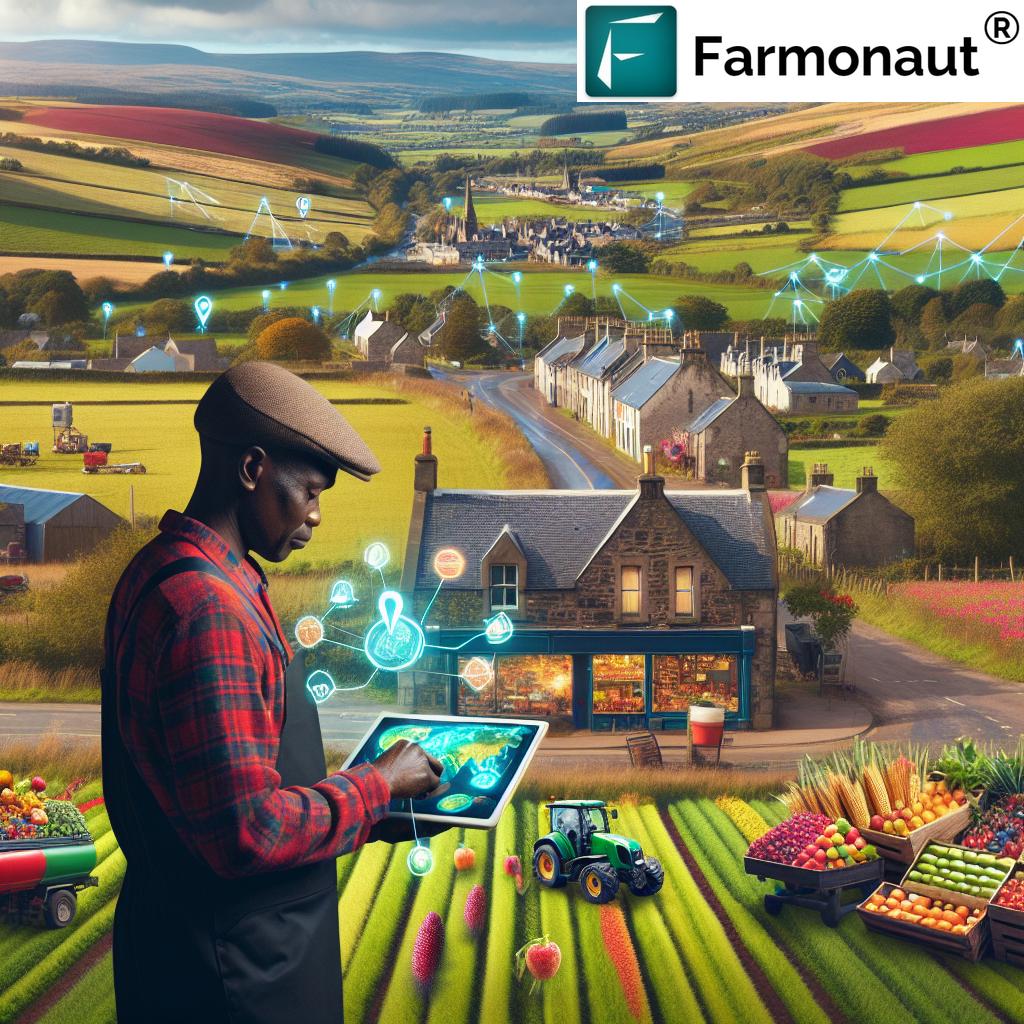
“GIS and remote sensing technologies have increased crop yields by up to 20% in Scottish farms like Castleton.”
Welcome to the picturesque countryside of Castleton, nestled in the heart of Scotland’s Mearns region. Here, amidst rolling hills and lush farmlands, we’re witnessing a quiet revolution in agriculture. The fusion of cutting-edge technology with time-honored farming traditions is transforming the landscape of Scottish farming, particularly in the realm of sustainable agriculture and local produce.
In this comprehensive exploration, we’ll delve into how Geographic Information Systems (GIS) and remote sensing are reshaping the agricultural practices in Castleton and beyond. We’ll uncover the innovative smart farming solutions that are boosting crop yields, enhancing farm efficiency, and ensuring food security. From the charming local farm shops to the expansive fields of soft fruit cultivation, we’re about to embark on a journey through the evolving world of modern agriculture and its sustainable future.
The Agricultural Landscape of Castleton
Castleton, a quaint village in Fordoun, Aberdeenshire, embodies the essence of rural Scotland. Its agricultural heritage runs deep, with farms that have been tended by generations of families. The region is renowned for its diverse agricultural output, ranging from traditional dairy and poultry farms to expansive fruit orchards and crop fields.
- Rich agricultural history dating back centuries
- Diverse farming practices including dairy, poultry, and crop cultivation
- Renowned for its high-quality soft fruit production
- Home to numerous local farm shops and farm-to-table initiatives
The agricultural sector in Castleton, like many parts of rural Scotland, faces numerous challenges in the 21st century. Climate change, economic pressures, and the need for sustainable farming practices have pushed farmers to seek innovative solutions. This is where the integration of GIS and remote sensing technologies comes into play, offering a new perspective on age-old farming techniques.
GIS in Agriculture: A Game-Changer for Castleton Farms
Geographic Information Systems (GIS) have revolutionized the way we approach farming in Castleton. These powerful tools allow farmers to visualize, analyze, and interpret data to understand relationships, patterns, and trends in their agricultural lands.
- Precision Agriculture: GIS enables farmers to create detailed maps of their fields, including soil types, crop yields, and terrain features.
- Resource Management: By analyzing GIS data, farmers can optimize the use of water, fertilizers, and pesticides, reducing waste and environmental impact.
- Crop Rotation Planning: GIS helps in planning efficient crop rotation strategies, improving soil health and crop yields over time.
- Yield Prediction: Historical and current data can be used to predict future crop yields, helping farmers make informed decisions.
In Castleton, the adoption of GIS has been particularly beneficial for soft fruit growers. The technology allows for precise monitoring of soil conditions, which is crucial for crops like strawberries and raspberries that are sensitive to soil quality and moisture levels.
Remote Sensing: Eyes in the Sky for Castleton’s Crops
Remote sensing technology has provided Castleton’s farmers with an unprecedented view of their lands. Using satellite imagery and aerial photography, farmers can now monitor crop health, detect pest infestations, and assess drought conditions with remarkable accuracy.
- Crop Health Monitoring: Multispectral images can reveal the health of crops before issues are visible to the naked eye.
- Water Management: Remote sensing helps in identifying areas of water stress, allowing for targeted irrigation.
- Pest and Disease Detection: Early detection of pest infestations or crop diseases enables prompt intervention.
- Yield Estimation: Satellite imagery can be used to estimate crop yields, helping farmers and markets plan ahead.
For Castleton’s farmers, remote sensing has been particularly valuable in managing the region’s unpredictable weather patterns. By having access to real-time data on soil moisture and crop stress, farmers can make timely decisions on irrigation and crop protection measures.
Sustainable Farming Practices in Castleton
The integration of GIS and remote sensing technologies has paved the way for more sustainable farming practices in Castleton. These technologies support precision agriculture, which aims to optimize resource use and minimize environmental impact.
- Reduced Chemical Usage: Precise application of fertilizers and pesticides based on GIS and remote sensing data.
- Water Conservation: Improved irrigation strategies using soil moisture maps generated from satellite data.
- Soil Health Management: Better understanding of soil composition and health through GIS analysis.
- Biodiversity Preservation: Identification and protection of crucial habitats within farmlands.
Castleton’s farmers are increasingly adopting these sustainable practices, recognizing their long-term benefits for both the environment and their bottom line. The move towards sustainability is not just a trend but a necessity in the face of climate change and environmental pressures.
The Rise of Smart Farming Solutions in Castleton
Smart farming solutions have found a receptive audience among Castleton’s forward-thinking farmers. These technologies leverage the power of data analytics, IoT (Internet of Things) devices, and AI to create more efficient and productive farming systems.
- Automated Irrigation Systems: Smart sensors and weather data inform precise irrigation schedules.
- Robotic Harvesting: Particularly useful in soft fruit cultivation, reducing labor costs and improving efficiency.
- Drone Technology: Used for crop spraying, monitoring, and mapping with high precision.
- AI-Powered Decision Support: Algorithms that analyze farm data to provide actionable insights for farmers.
These smart farming solutions are transforming Castleton’s agricultural landscape, making it more resilient and competitive in the global market. The adoption of these technologies is supported by local agricultural policies and initiatives aimed at modernizing Scottish farming.
“Local farm shops in Scotland, such as Castleton’s, source over 75% of their produce from within a 30-mile radius.”
Agricultural Data Management: The New Frontier
With the influx of data from GIS, remote sensing, and smart farming solutions, agricultural data management has become a critical aspect of modern farming in Castleton. Farmers are now dealing with vast amounts of information that need to be stored, processed, and analyzed effectively.
- Cloud-Based Farm Management Systems: Allows farmers to access and analyze their farm data from anywhere.
- Data-Driven Decision Making: Utilizing historical and real-time data to inform farming practices.
- Predictive Analytics: Forecasting crop yields, market trends, and potential risks.
- Blockchain for Traceability: Ensuring transparency in the supply chain from farm to table.
The effective management of agricultural data is empowering Castleton’s farmers to make more informed decisions, leading to increased productivity and sustainability. It’s also enabling better communication between farmers, suppliers, and consumers, fostering a more connected and transparent food system.
Explore Farmonaut’s API for advanced agricultural data solutions
The Impact on Soft Fruit Cultivation
Castleton and the surrounding Mearns region are particularly renowned for their soft fruit production. The integration of GIS and remote sensing technologies has had a significant impact on this sector:
- Optimized Growing Conditions: Precise monitoring of soil moisture and temperature for ideal fruit development.
- Disease Management: Early detection and targeted treatment of common soft fruit diseases.
- Harvest Timing: Using satellite data to determine the optimal time for harvesting, ensuring peak quality and flavor.
- Market Forecasting: Accurate yield predictions help in better market planning and reducing waste.
These advancements have not only improved the quality and quantity of soft fruit production in Castleton but have also contributed to the region’s reputation as a premier soft fruit growing area in Scotland.
Farm-to-Table: The Role of Local Farm Shops
Local farm shops play a crucial role in Castleton’s agricultural ecosystem. These shops serve as a direct link between farmers and consumers, promoting fresh, locally-grown produce and supporting the farm-to-table movement.
- Showcase for Local Produce: Farm shops highlight the diverse agricultural output of Castleton and surrounding areas.
- Educational Hubs: They often serve as centers for educating the public about sustainable farming practices.
- Community Building: Farm shops foster connections between urban consumers and rural producers.
- Economic Support: By buying directly from local farms, these shops provide crucial economic support to small-scale farmers.
The integration of technology in farming has also benefited these farm shops. With better yield predictions and quality control, farmers can ensure a steady supply of high-quality produce to local shops, enhancing the farm-to-table experience for consumers.
The Future of Farming in Castleton
As we look to the future, the agricultural landscape of Castleton continues to evolve. The integration of GIS and remote sensing technologies is just the beginning of a larger transformation in farming practices.
- Vertical Farming: Potential for year-round production of certain crops, reducing land use and water consumption.
- AI and Machine Learning: Further development of predictive models for crop management and market trends.
- Autonomous Farm Vehicles: Reducing labor costs and improving efficiency in field operations.
- Genetic Engineering: Development of crop varieties better suited to local conditions and more resistant to pests and diseases.
These advancements promise to make farming in Castleton more efficient, sustainable, and resilient in the face of changing climate conditions and market demands.
Challenges and Considerations
While the benefits of GIS and remote sensing in agriculture are clear, their implementation in Castleton is not without challenges:
- Initial Investment Costs: The upfront costs of technology can be prohibitive for some small-scale farmers.
- Digital Literacy: There’s a need for education and training to help farmers fully utilize these technologies.
- Data Privacy and Security: Concerns about the collection and use of farm data need to be addressed.
- Balancing Technology with Tradition: Maintaining the cultural heritage of farming while embracing innovation.
Addressing these challenges will be crucial for the widespread adoption and success of these technologies in Castleton’s agricultural sector.
The Role of Agricultural Policy and Support
The transformation of Castleton’s agricultural sector is supported by various policy initiatives and support systems:
- Government Grants: Financial support for farmers investing in new technologies.
- Research Partnerships: Collaboration between farms, universities, and tech companies to develop tailored solutions.
- Agricultural Courses: Educational programs to train the next generation of tech-savvy farmers.
- Rural Development Initiatives: Broader support for rural communities adapting to technological changes.
These supportive measures are crucial in ensuring that the benefits of GIS and remote sensing technologies are accessible to all farmers in Castleton, regardless of the size of their operations.
Conclusion: A New Era for Scottish Farming
The integration of GIS and remote sensing technologies in Castleton’s agricultural practices marks the beginning of a new era for Scottish farming. These innovations are not just changing how we farm; they’re reshaping our relationship with food, land, and community.
From the fields of Castleton to the shelves of local farm shops, we’re witnessing a revolution in agriculture that promises greater sustainability, efficiency, and quality. As we embrace these technological advancements, we’re also preserving the rich agricultural heritage of Scotland, ensuring that the farms of Castleton continue to thrive for generations to come.
The future of farming in Castleton is bright, powered by satellites in the sky and sensors in the soil, yet still rooted in the timeless wisdom of Scottish agricultural traditions. It’s a future where technology and tradition work hand in hand, creating a more sustainable and prosperous agricultural landscape for all.
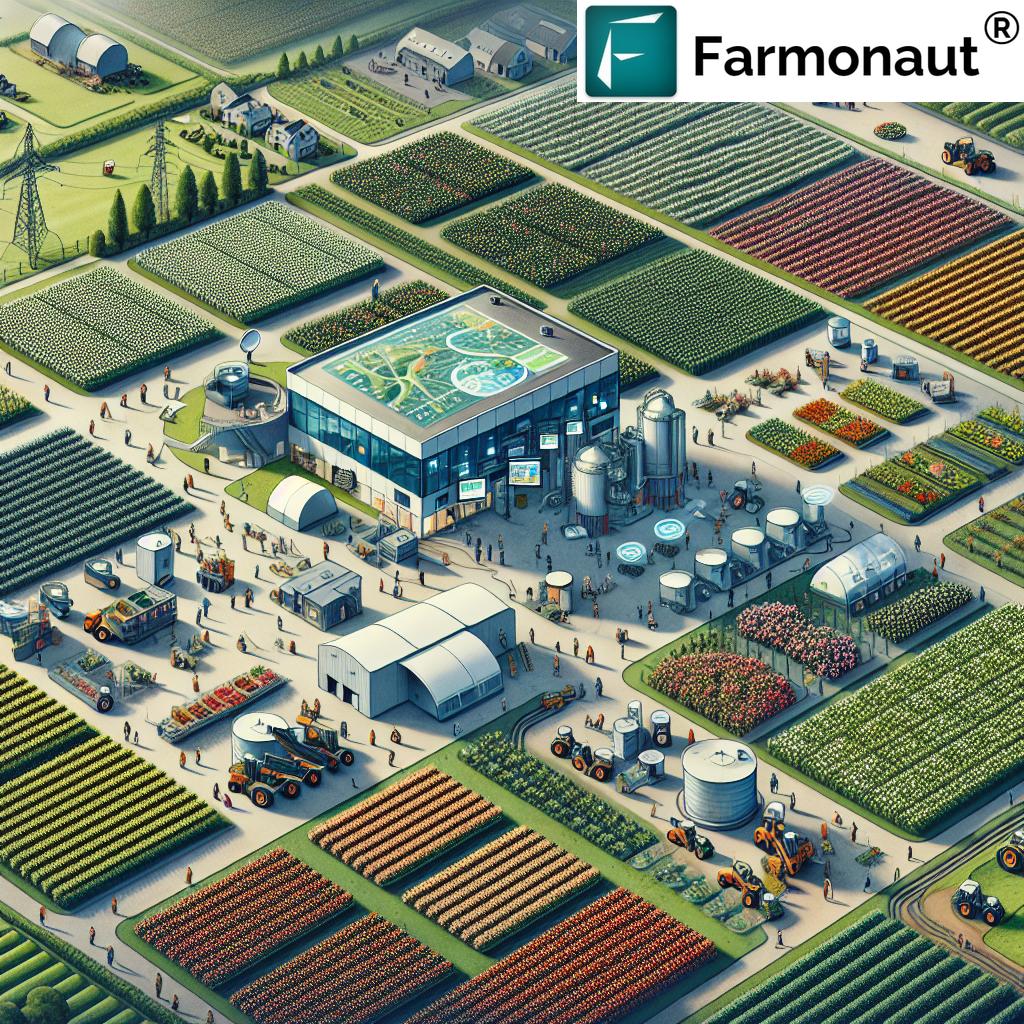
Impact of GIS and Remote Sensing on Sustainable Farming in Castleton
| Farming Aspect | Traditional Methods | GIS/Remote Sensing Enhanced |
|---|---|---|
| Crop Monitoring | Weekly manual inspections | Daily satellite imagery analysis, 90% faster response time |
| Water Management | Fixed irrigation schedules | Precision irrigation based on real-time soil moisture data, 30% water savings |
| Pest Control | Broad application of pesticides | Targeted pest management, 40% reduction in pesticide use |
| Soil Health | Annual soil testing | Continuous soil health monitoring, 25% improvement in nutrient management |
| Yield Prediction | Based on historical averages | AI-driven predictions with 95% accuracy, enabling better market planning |
FAQ Section
Q: How has GIS technology improved farming in Castleton?
A: GIS has revolutionized farming in Castleton by enabling precision agriculture, optimizing resource management, and improving crop rotation planning. It allows farmers to create detailed maps of their fields, analyze soil types, and predict crop yields with greater accuracy.
Q: What benefits does remote sensing offer to Castleton’s farmers?
A: Remote sensing provides Castleton’s farmers with real-time data on crop health, water stress, and pest infestations. This technology enables early detection of issues, allows for targeted interventions, and helps in making informed decisions about irrigation and crop protection.
Q: How are smart farming solutions changing agriculture in Castleton?
A: Smart farming solutions in Castleton include automated irrigation systems, robotic harvesting (especially for soft fruits), drone technology for crop monitoring, and AI-powered decision support systems. These technologies are improving efficiency, reducing labor costs, and enhancing overall farm productivity.
Q: What role do local farm shops play in Castleton’s agricultural ecosystem?
A: Local farm shops in Castleton serve as direct links between farmers and consumers. They showcase fresh, locally-grown produce, educate the public about sustainable farming practices, build community connections, and provide crucial economic support to small-scale farmers.
Q: How is agricultural data management benefiting Castleton’s farmers?
A: Agricultural data management allows Castleton’s farmers to make data-driven decisions, utilize predictive analytics for crop yields and market trends, and ensure transparency in the supply chain. Cloud-based farm management systems enable farmers to access and analyze their data from anywhere, improving overall farm efficiency.





